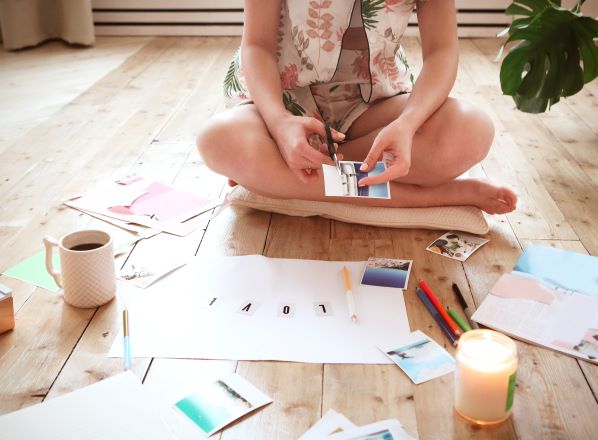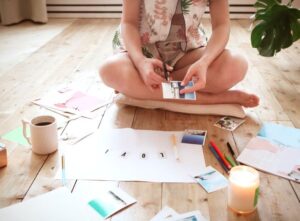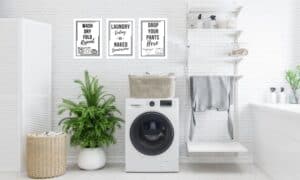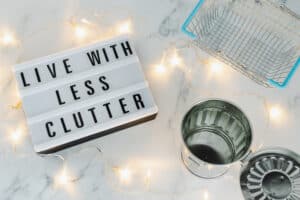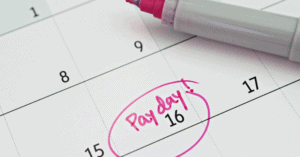There seems to be a lot of hype at the moment about manifesting with ease, and alignment, and I’m here for it! Except if you don’t know how to start with manifesting, this can all feel like it’s too woo woo and nothing you can realistically do for yourself.
When I’m talking to my clients about manifesting their goals and dreams, the first thing I always cover with them is how to make a vision board. This is because if you do it right, making a vision board (and actually using it) can be an incredibly powerful tool in your manifesting toolkit.
If you have tried a vision board before and it didn’t work for you, or you’re keen to avoid the common mistakes a lot of people make with their vision boards, you can try my Manifesting Mastery with Vision Boards course to make sure you nail it first time!
Otherwise, if you’re ready to dive in and want to make sure you have the basics covered, then grab my free Vision Board Checklist and use it as you work through the steps below.
What is a vision board?
Before we get started grabbing our supplies, let’s talk about what a vision board actually is, and what is the point of a vision board (note it is sometimes also called a dream board or a goals board).
A vision board is a collection of pictures, words, and phrases that are designed to inspire you toward a particular goal or desire and help you to visualize your dreams. When I first started using vision boards, most people would use a cork board or poster board for their vision board, but some are now moving to a digital vision board instead, so you should do whichever works best for you. I cover how to make both of these below.
The idea behind a vision board is pretty simple. By having a vision board in a prominent and visible place with your goals and intentions, your mind keeps being reminded of these focus areas, and your subconscious will work away at them. Vision boards are linked to the Law of Attraction, which is essentially about attracting into your life what you are focusing on.
Sometimes when we set out to achieve new goals, we start out very excited and write them all down. However, at some point we lose the paper with the goals written on them, or never refer back to the journal or planner that we wrote them in, and forget about the goals we set out for ourselves. A vision board solves this issue by keeping your goals front of mind every day, and invoking positive emotions as you look at them.
Do vision boards work?
There’s plenty of research to say that vision boards work! Visualization is a powerful technique, and Psychology Today has reported that athletes who visualized their training exercises received almost the same benefits as those who physically undertook the exercises.
Some studies have shown that just visualizing a goal (rather than the work to get there) may not be as effective, so keep this in mind when creating your vision board – you may also need to consider the work or steps to achieve your goal.
Whilst visualization and manifestation may seem all a bit woo-woo, there really isn’t really any magic to this. Regular visualization will activate your subconscious mind, and makes you notice things that were there before but that you weren’t focusing on.
I have seen this particularly when it comes to opportunities in my business. Before I was focusing on particular goals, opportunities passed me by because I wasn’t ready to see them. Now I have visualized on a regular basis what success will look like for me, I know what areas I want to focus on to get to the next stage, and I am seeing opportunities everywhere to help me to get there.
What we focus on expands into our life. I’m seeing it happen for me, so I’m happy to share it with you!
What should you put on your vision board?
The following steps and examples will help you to work out what to include on your vision board.
Step 1: Reflect on what you’ve already accomplished this year
What went well for you this year and how did you achieve it? Is there anything that you have achieved that you need to continue to focus on, or want to build on? If so, consider including these things when you create your vision board.
For example, if you got a promotion this year by putting your hand up for new challenges at work, you might want to put something around taking on new challenges as a continued focus. If you ran a half marathon this year, perhaps you want to include something on your vision board which will encourage you to run another one faster, or even to run a full marathon.
Step 2: Think about what you want to change
What didn’t go so well this year? Or what did you hope to achieve but didn’t make significant steps towards? Failing to plan, is planning to fail, so if there is something you do want to achieve, you need to think about what you will do to get there this year and how to incorporate that into your vision board.
Your vision board is about feelings, desires, emotions, and things that inspire you, as well as goals. When you are choosing what to put on your board, think about how that particular thing will make you feel. This is a useful exercise as it will help you to generate those same feelings and desires each time you look at the board.
For me, I had thought at the beginning of the year I wanted to lose some weight, but didn’t set any tangible goals or habits to get there, and surprise surprise, I didn’t lose any weight. For my 2023 vision board, I am actually focusing on health. Whilst I want to lose some weight, I really want to feel healthier, and that is all around habits of eating, drinking, and exercise.
The health section of my vision board has someone running in the outdoors, has words like ‘energized’ and ‘envigorated’, and has pictures of fish, vegetables and fruit. Visualizing and acting on these areas will flow into feeling better and losing weight. Focusing too much on weight loss (as many of us do) feels more like a deprivation focus (don’t eat this, don’t drink that) than a health focus of feeling better and full of energy.
Step 3: Decide on your next big goal
I find it most useful to have dreams and goals for several areas of my life as it encourages me to do new things, as well as maintain things that are going well and not forget them. However, I have one goal that I consider to be my big goal for the year.
My big goal for 2023 is to earn significant income from my businesses, and so that is the central focus for my board this year. I put this right in the middle of my board, and in comparison to the other sections it takes up more space.
The other things that I need to keep focusing on also get included on my vision board. For example, my relationship with my husband is great, but I make sure that my vision board includes a picture of us in the midst of a happy moment, as I want to see that every day as part of my vision for 2023.
Step 4 : Think about the direction you want to take your life next.
When thinking about the direction you want your life to take next, this can be one area or it can be many.
I like to split my vision board and goal setting into sections, as that helps me get a picture overall of my ideal life. The sections that I have used in the past are relationships (family / friends / spouse), home, finances, career / work, travel, health, and me (this covers everything not captured already, and includes things like new hobbies or personal development).
The sections that you want to use might be different, or you may choose your vision board to focus on only one or two things rather than a whole ideal life. The beauty of a vision board is that there is no right or wrong way to do it, it’s all about focusing on you.
I write each of my sections as a heading on a piece of paper, and then I look at my goals for those, and the feelings that I want to evoke.
My vision board for 2023 covers quite a few areas, as 2023 is going to be a big year for me. My big goal is regarding my business and coaching practice. However, my husband and I recently moved house to a more affordable area, and so I need to visualize how the space and new start will make me feel, and how I want to create our dream home from the bones of what is there. I am also going to be focusing on continued success in my career, on being healthy, and on investing our money in a way that helps us to live the life we want. I may need a bigger board!
Step 5: Decide what is going on your vision board
From the four steps above, you have a list of things to keep doing, new goals, desires, and aspirations, and have thought about the various aspects of your life and the direction you want them to take. However, you don’t need to put all of this on your vision board.
From the list that you have created, work out which are the most important to you to focus on. These are the things you want to have visual representations of on your vision board. Now you can move to the fun part, actually making your vision board!
Tip: Be clear on your WHY
As you are setting your goals, intentions, and affirmations, make sure you are drilling down into your why. If you want to buy a house in the Hamptons, then think really deeply about why you want that, as it helps you to get clarity on your goals and your reasons for wanting them.
Be aware that sometimes what you think you want is not what you actually want, and getting clarity on why you want something will help to flush out those goals that are not your real goals, but are the result of societal pressure, parental expectations or other external factors.
As an example, I used to think I wanted to buy a house overlooking the beach near where I currently live. My friends all own houses around here, and so I thought in time I would do the same. But I am based in a very high cost of living area, and I would have to work so hard to pay off a mortgage for this area, that I might never get to enjoy the house and the beach it is overlooking.
By digging into my why, I realised what I wanted (and the pictures I wanted on my vision board) was the ideal relaxed life of living near a beach, where I could walk to the sea every morning, and sit with a coffee and a lovely view before starting my day. It didn’t need to be the area I currently live, and reframing this thinking has prompted us to buy a house a few hours away up the coast. We moved recently, and the cost of living is cheaper and we can own a lovely house without millions of dollars in mortgage hanging over our heads (which would definitely not have been relaxing!).
This is another example of being open to the opportunity and willing to take up what the universe offers. We have had a challenging last few years as many people have, but one benefit is that it has shown me that my job does not need me to travel to the office every day. By being open to change, and imagining a relaxed lifestyle on the coast that is not right next to the city, we have been able to manifest our visions and make the move.
How to make a vision board
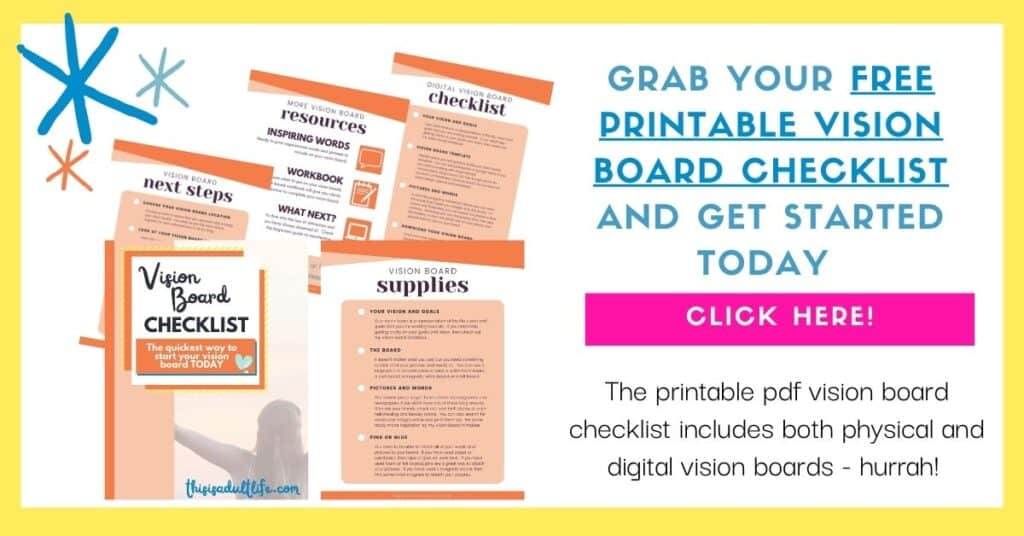
Now you know the goals and concepts that you want on your vision board, you need to actually make it! Here’s how you make your vision board.
Supplies you need for a vision board
Here’s all the supplies you will need to make your board:
- Backing Board (I like this grey felt board) or cork board
- Pictures and words. The easiest place to get these is from old magazines and newspapers. If you don’t have any of these lying around, then ask your friends, check out local thrift stores, or even hairdressing and beauty salons.
- Pins, glue or tape – I use pins on my felt board to make things easy to move around later
Collect your images, words and phrases
Find pictures and words that represent your goals and inspire you. Try to keep looking until you find a picture that really resonates with you. If you have seen a picture that does link to your goal but makes you feel a bit “meh”, you will never really connect with the image once it is on your vision board.
For example, when I wanted to move to a home next to the beach, my vision board had a picture of a lovely beach at sunrise, it didn’t include a picture of the home itself.
Don’t forget to also cut out words or phrases that invoke powerful feelings in you. For my health section, I have used words like “energized”. You might have similar health words, or relationship words like “loved” or “secure”. You might even have affirmations – one of my favorites is “the quality of your life is determined by the quality of your habits”. It’s a daily reminder to me that a single setback or failure doesn’t define me, but the habits I choose to practice every day will make the difference.
Everything you are collecting for your vision board should have meaning to you, and you should be able to feel it the moment you look at the word or picture. If you have to spend some time working out what a word or picture was supposed to represent, it shouldn’t be on your vision board! Remember, you don’t have to only use pictures from magazines, you can look for images on the internet or use your own photographs.
How to position pictures and words on your vision board
Personally, I separate my board into my categories as mentioned above. I put my one big goal in the middle and then have my other categories in their own spot on the board. That helps me to visualize each area of my life and what I want for that, and I add the words and photographs to their own section.
As with everything else, there is no right or wrong way to do it. If you like to have all of your words and images mixed up, then that is how you should create your vision board. My top tip is not to glue or pin anything until you have laid out all of your words and pictures and are happy with how the vision board makes you feel. It usually takes me a couple of goes at positioning all of my words and pictures before I feel everything is in the right place.
Where should you put your vision board?
Ideally you should put your vision board somewhere that you will see it every day. As I said above, this is all about having your visual reminders right there, and putting your visions and dreams into your subconscious. Your mind needs to see the board regularly for your subconscious to do its thing!
I normally hang my vision board up in my bedroom so that I see it before I go to sleep at night and first thing when I wake up. I like the idea that looking at my vision board before I go to sleep might prompt my subconscious to so come creative thinking around my goals whilst I am asleep.
If you have an office, either at home or at work, that you use everyday then that could also be a good place for your board.
If you have a digital vision board (see below for how to make those), then either print it out, or put it as your screensaver, so that you are seeing it regularly.
How to make a digital vision board
You should firstly complete all of the steps above relating to goal setting and working out what you want to focus on for the year.
Then, you can create an account with either Canva (it’s free) or PicMonkey (it’s paid). Canva has free photos included, and the PicMonkey subscription does too. Use the picture search function in either of these tools to look for the pictures that you can connect with your goals. All of the pictures are well described, so you can search for “couple” or “beach” and there will be lots of pictures to choose from.
If you can’t find what you are looking for in their photo libraries, you can use free stock image sites like Pixabay, and then import the photo you like into Canva or PicMonkey.
You can then create a new design starting with a blank sheet, and position all of your pictures and words around your digital canvas. Both Canva and PicMonkey have text boxes so that you can add any words or affirmations that you need too – they are both great design tools so there’s lots of text effects you can use to make your board pop.
Once you have your digital vision board finalized, download it to your computer and you can save it as a background, or print it out.
If you don’t want to use an online tool like Canva, you can even just use a word or powerpoint document, and find free pictures using Google search.
What do you do once you have a vision board?
The point of having your vision board in a prominent place is to reflect on it daily. Every day you need to go look at your vision board and spend some time visualizing your goals.
You can say your goals out loud, or just use a few minutes to look at your board and quietly reflect on your goals. Personally, I think that speaking your goals is vital. That way you hear your goals and it makes them feel more attainable. I try to say them with conviction as if they’ve already happened. It makes me feel like this way the universe has already made them a reality.
Just doing this on a daily basis keeps your goals in your mind, and the power of visualization will do its thing.
Other questions people ask about vision boards
Do I change my vision board if my goals change?
A vision board doesn’t have to be static, so if your goals and focus areas are growing or changing through the year, you can change your vision board to reflect the changes to your goals. If you think you will be making lots of changes to your board, it may be easier to use pins to keep pictures and words in place, as these are easier to swap around than if you have glued everything to the board.
Personally, I don’t usually change my vision board, as I like to have board that represent a particular time of my life and the goals I was going after. When I am starting a new phase of life, I tend to sit down and redo my goal setting exercises, and then create a whole new board. Some things look similar across my boards, but others evolve and change as I do.
Even if you don’t keep all of your vision boards, it might be a nice momento to take a photo of it. I read one article by a woman who said she had kept all of her boards and liked to look back on them to see how she has grown and changed. I don’t have the space to keep lots of vision boards, but wish I did take photos of them all so I could look back at them.
Should I have one main vision board or several vision boards for different areas of my life?
As I have said many times through this article, there is no right or wrong way to complete your vision board. If it makes most sense to you to have different vision boards for the different areas of your life, then that’s what you should do.
Personally, I like to have just one vision board with a few categories on it, as I think I would get overwhelmed with lots of boards, and not actually take the time to focus on each of them and visualize my most important goals.
Some people like to have theme boards, and this could be something I look at in future for very specific areas. An example would be that if you have certain career aspirations, you might make a small career based vision board and put it on your office wall, or in a frame on your desk. This means each time you sit down to work, you have your career focused goals right there to help you visualize your future success.
How often should I update my vision board, or make a new vision board?
I’m starting to sound like a broken record here, but there is no right or wrong way to do this. You should update your vision board when the time is right for you.
I usually leave a little space on my board so that I can add one or two things if they become an important focus area for me during the year. But then I tend to do a whole new board every December, so that I have a fresh view of my goals and aspirations for the year to come. Usually, a couple of things carry over from year to year, and some are moved off the board to make way for new goals and aspirations.
Sometimes, if I have had a big life change (like when I had previous relationship breakups), I also consider redoing my board if it means a lot of my goals don’t feel relevant anymore.
Is a vision board the same as a mood board?
No. A mood board is generally related to design, so people create mood boards to collect ideas around a theme for a brand or design concept. An example is in interior design, where you can create a mood board before deciding on the concept for your master bedroom. A vision board is all about goals, feelings and aspirations, and is not generally used for branding or designing.
If I write down my goals, do I also need a vision board?
I have seen lots of questions about whether it is better to have a list of goals or a vision board. Once again (for the folks at the back), there is no right or wrong answer!
My process in making my vision board starts with writing down my goals. I then use this to build my vision board, because having a visual representation of my goals that I can see every day is a powerful tools for me.
If you are someone who uses a planner or journal every day, you may find that having your goals written in your planner or journal is enough. Or you may find that having a printed copy of your vision board in your journal is super helpful in keeping to your goals for the year.
If you aren’t sure what works best for you, why not give the vision board a try? You have nothing to lose and everything to gain.
How do I make a vision board if I don’t know what I want?
Goal setting isn’t a magical skill that some of us are blessed with and others are not. Learning to set goals is something that you get better at the more you practice it.
If you aren’t sure what you want, then try going through the reflection exercises above. This gets you to think about what went well during your last year, what you would like to have done better, and then to think about your life in segments.
Try also to focus on feelings rather than material things if you are struggling with your goals. How do you want to feel about your relationships? How do you want others with whom you have friendships to relationships to perceive you? What does financial security feel like to you? Use these feelings as the main basis of your vision board, and look for pictures that represent those feelings to you.
Remember that according to the Law of Attraction, what you focus on expands. You’ll be amazed at how things just start popping up all over the place once you set the intention for what you want and how you want to feel.
For more support and tips in making your vision board, try my Manifesting Mastery with Vision Boards course. I want all of our dreams to become a reality!
Let me know how your vision board is going in the comments box below.
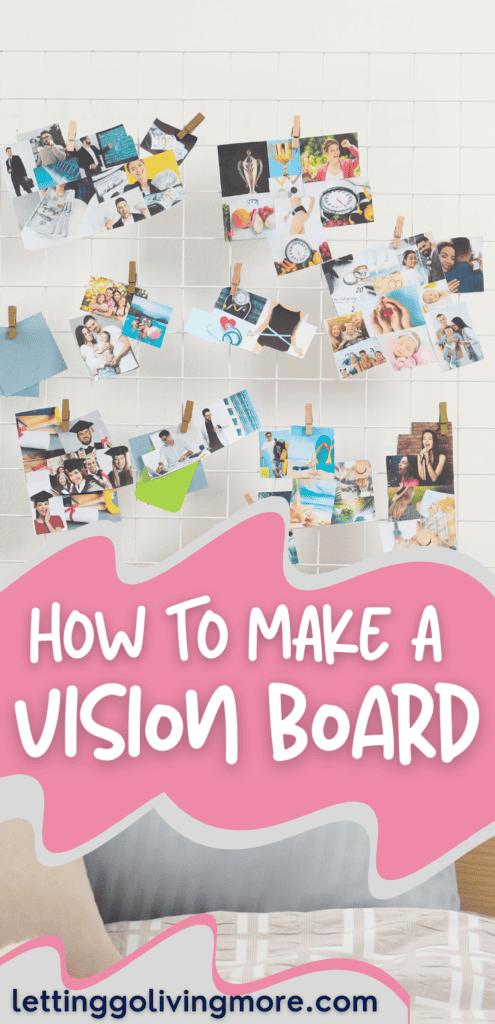
Sharing is caring!

